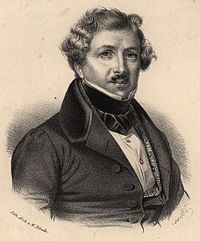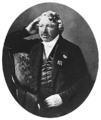- Louis Daguerre
-
Louis Daguerre 
Louis-Jacques-Mandé DaguerreBorn November 18, 1787
Cormeilles-en-Parisis, Val-d'Oise, FranceDied July 10, 1851 (aged 63)
Bry-sur-Marne, FranceKnown for invention of the daguerreotype process Signature 
Louis-Jacques-Mandé Daguerre (November 18, 1787 – July 10, 1851) was a French artist and physicist, recognized for his invention of the daguerreotype process of photography.
Contents
Biography
Daguerre was born in Cormeilles-en-Parisis, Val-d'Oise, France. He apprenticed in architecture, theatre design, and panoramic painting with Pierre Prévost, the first French panorama painter. Exceedingly adept at his skill for theatrical illusion, he became a celebrated designer for the theater and later came to invent the Diorama, which opened in Paris in July 1822.
In 1822[1] Joseph Nicéphore Niépce produced the world's first permanent photograph (known as a Heliograph). Daguerre partnered with Niépce three years later, beginning a four-year cooperation.[2] Niépce died suddenly in 1833. The main reason for the "partnership", as far as Daguerre was concerned, might have been connected to his already famous dioramas. Niepce was a printer and his process was based on a faster way to produce printing plates. Daguerre perhaps thought that the process developed by Niepce could help speed up his diorama creation.
Daguerre announced the latest perfection of the Daguerreotype, after years of experimentation, in 1839, with the French Academy of Sciences announcing the process on January 7 of that year. Daguerre's patent was acquired by the French Government, and, on August 19, 1839, the French Government announced the invention was a gift "Free to the World."
Daguerre and Niépce's son obtained a pension from the Government in exchange for freely sharing the details of the process. Daguerre died on July 10 1851 of a heart attack in Bry-sur-Marne, 12 km (7 mi) from Paris. A monument marks his grave there.
Daguerre's name is one of the 72 names inscribed on the Eiffel tower.
Competition with Talbot
The work on the Daguerre process was taking place at the same time as that of William Fox Talbot in England on the calotype process. Both men knew that they were working on a process that would revolutionize the art world. The Grand Tours which were so popular were illustrated by drawings of scenes and the "photographic" process would improve the quality and ease with which these popular holiday memories could be produced.
To protect his own invention, Daguerre himself registered the patent for Britain on August 12, 1839 (a week before France declared it "Free to the World"), and this greatly slowed the development of photography in that nation. Great Britain was to be the only place the patent was enforced. Antoine Claudet was one of the few people legally able to take daguerreotypes there.
Daguerre did not need to make money from the invention to live, since he had been pensioned by the French government.[3] Fox Talbot spent a considerable amount of money on his process (est. £5,000 in 1830s money) and licensed the process to British photographers where it was used instead of the Daguerreotype.[citation needed]
Development of the Daguerreotype
 "Boulevard du Temple", taken by Daguerre in 1838 in Paris, was the first photograph of a person. The image shows a street, but because of the over ten minute exposure time the moving traffic does not appear. The exceptions are the man and shoe-shine boy at the bottom left, and two people sitting at a table nearby who stood still long enough to have their images captured. (click photo to enlarge)
"Boulevard du Temple", taken by Daguerre in 1838 in Paris, was the first photograph of a person. The image shows a street, but because of the over ten minute exposure time the moving traffic does not appear. The exceptions are the man and shoe-shine boy at the bottom left, and two people sitting at a table nearby who stood still long enough to have their images captured. (click photo to enlarge)
The first permanent photograph was made in 1826 by Joseph Nicéphore Niépce, building on a discovery by Johann Heinrich Schultz (1724): a silver carbonate or silver chloride and chalk mixture darkens under exposure to light. Niépce and Daguerre refined this process. Daguerre first exposed silver-coated copper plates to iodine, obtaining silver iodide. Then he exposed them to light for several minutes, coated the plate with mercury vapor heated to 75° Celsius (to amalgamate the mercury with the silver) and finally fixing the image in salt water. These ideas led to the famous Daguerreotype.
The resultant plate produced an exact reproduction of the scene. The image was laterally reversed -- as images in mirrors are -- unless a second mirror was used during exposure to flip the image. The image could only be viewed at an angle and needed protection from the air and fingerprints so was encased in a glass-fronted box.
Some ambrotypes were passed off as Daguerreotypes by being placed in these type of boxes. But the process was cheaper involving a weakly developed glass card or paper to appear as a positive. Tintypes also were "boxed" as Daguerrotypes.
Daguerreotypes were usually portraits; the rarer views are much sought-after and are more expensive. The portrait process took several minutes and required the subjects to remain stock still. Samuel Morse was astonished to learn that Daguerrotypes of streets of Paris did not show any humans, until he realized that due to the long exposure times all moving objects became invisible. The time was later reduced with the "faster" lenses such as Petzval's portrait lens, the first mathematically calculated lens.
In 1849, Daguerreotype images photographed by the famous Russian photographer Sergei Lvovich Levitsky (1819-1898) while on a mission to the Caucasus in 1843, were exhibited by the famous Parisian optician Chevalier at the Paris Exposition of the Second Republic as an advertisement of their lenses. Levitsky's use of the Chevalier lens which used two cemented double lenses improved the camera's focusing ability, thus reducing the time needed to capture an image for portraiture and landscape photography. Levitsky's Dageurreotypes would receive the Exposition's gold medal; the first time a prize of its kind had ever been awarded to a photograph.
The Daguerreotype was the Polaroid of the day, producing a single image which was not reproducible (unlike the Talbot process). Despite this drawback, millions of Daguerreotypes were produced. By 1851, the year of Daguerre's death, the Fox Talbot negative process was refined by the development of the wet collodion process, whereby a glass negative enabled a limitless number of sharp prints to be made. These developments made the Daguerreotype redundant and the process very soon disappeared.
Selected works
See also
- Diorama
- John Herschel
- Palladiotype
- Photographic processes
- Platinotype Company
- William Willis
References
- ^ "The First Photograph - Heliography". http://www.hrc.utexas.edu/exhibitions/permanent/wfp/heliography.html. Retrieved 2009-09-29. "from Helmut Gernsheim's article, "The 150th Anniversary of Photography," in History of Photography, Vol. I, No. 1, January 1977: ... In 1822, Niépce coated a glass plate ... The sunlight passing through ... This first permanent example ... was destroyed ... some years later."
- ^ Stokstad, Marilyn; David Cateforis, Stephen Addiss (2005). Art History (Second ed.). Upper Saddle River, New Jersey: Pearson Education. pp. 964–967. ISBN 0-13-145527-3.
- ^ "'A State Pension for L. J. M. Daguerre for the secret of his Daguerreotype technique' by R. Derek Wood". http://www.webarchive.org.uk/wayback/archive/20100311230213/http://www.midley.co.uk/Pension/Pension.htm. Wood, R.D., Annals of Science, 1997, Vol 54, pp. 489-506.
- Carl Edwin Lindgren. Teaching Photography in the Indian School. Photo Trade Directory: 1991. India International Photographic Council. Edited: N. Sundarraj and K. Ponnuswamy. VII IIPC-SIPATA Intl. Workshop and Conference on Photography - Madras, p. 9.
- R. Colson (ed.), Mémoires originaux des créateurs de la photographie. Nicéphore Niepce, Daguerre, Bayard, Talbot, Niepce de Saint-Victor, Poitevin, Paris 1898
- Helmut and Alison Gernsheim, L.J.M. Daguerre. The History of the Diorama and the Daguerreotype, London 1956 (revised edition 1968)
- Beaumont Newhall, An Historical and Descriptive Account of the Various Processes of the Daguerreotype and the Diorama by Daguerre, New York 1971
- Hans Rooseboom, What’s wrong with Daguerre? Reconsidering old and new views on the invention of photography, Nescio, Amsterdam, 2010 (www.nescioprivatepress.blogspot.com)
- Daguerre, Louis (1839). History and Practice of the Photogenic Drawing on the True Principles of the Daguerreotype with the New Method of Dioramic Painting. London: Stewart and Murray. http://books.google.com/books?id=gnUEAAAAQAAJ&dq=A%20practical%20description%20of%20that%20process%20called%20the%20daguerreotype&pg=PP9#v=onepage&q&f=false.
External links
- Daguerre (1787–1851) and the Invention of Photography from the Metropolitan Museum of Art.
- Louis Daguerre (1787–1851) from World Wide Art Resources.
- Daguerre, Louis Jacques Mande by Robert Leggat.
- Daguerre and the daguerreotype An array of source texts from the Daguerreian Society web site
- Daguerre's Boulevard du Temple photograph - a discussion on its making and subsequent history.
- Daguerre Memorial in Washington D.C.
- Louis Daguerre Encyclopedia Britannica
Categories:- 1787 births
- 1851 deaths
- People from Cormeilles-en-Parisis
- French inventors
- French artists
- French chemists
- French photographers
- 19th-century photographers
- Pioneers of photography
- Recipients of the Pour le Mérite (civil class)
Wikimedia Foundation. 2010.





